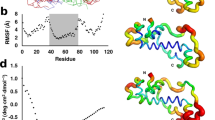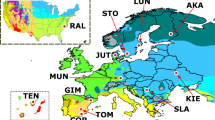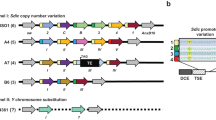Abstract
The biological properties of the P element of Drosophila melanogaster differ from those of other mobile elements in this genus in that its mobility is associated with dysgenic traits that might be expected to limit its distribution or spread1. The P element is widely distributed among natural populations of D. melanogaster, but is absent from strains that have been maintained in the laboratory for more than thirty years2. This observation prompted speculation that the P element has recently invaded and spread horizontally through D. melanogaster3,4, a hypothesis supported by the observation that P elements are absent from the D. melanogaster sibling species5. However, sequences homologous to P elements have been found recently in Drosophila paulistorum, a quite distant relative6. This finding undermines any simple hypothesis about the origin of P elements, and demands a thorough analysis of the distribution and conservation of the P element within the subgenus Sophophora. We show here that the P element is present in every species group in the subgenus Sophophora, but that its distribution within species groups can be discontinuous. The P homologues from different species are not identical; furthermore, their genomic localization differs from that found in D. melanogaster.
This is a preview of subscription content, access via your institution
Access options
Subscribe to this journal
Receive 51 print issues and online access
$199.00 per year
only $3.90 per issue
Buy this article
- Purchase on Springer Link
- Instant access to full article PDF
Prices may be subject to local taxes which are calculated during checkout
Similar content being viewed by others
References
Engels, W. R. A. Rev. Genet. 17, 315–344 (1983).
Kidwell, M. G. Genet. Res. 33, 105–117 (1979).
Kidwell, M. G. in The Genetics and Biology of Drosophila, Vol. 3 (eds Ashburner, M., Carson, H. & Thompson, J.) 125–154 (Academic, London, 1982).
Kidwell, M. G. Proc. natn. Acad. Sci. U.S.A. 80, 1655–1659 (1983).
Brookfield, J. F., Montgomery, E. & Langley, C. H. Nature 310, 330–331 (1984).
Daniels, S. B., Strausbaugh, L. D., Ehrman, L. & Armstrong, R. Proc. natn. Acad. Sci. U.S.A. 81, 6794–6797 (1984).
Throckmorton, L. H. in Handbook of Genetics Vol. 3 (ed. King, R. C.) 421–469 (Plenum, New York, 1975).
Beverly, S. M. & Wilson, A. C. J. molec. Evol. 21, 1–13 (1984).
Kidd, S., Lockett, T. J. & Young, M. W. Cell 34, 421–433 (1983).
Southern, E. M. J. molec. Biol. 98, 503–517 (1975).
Spradling, A. C. & Rubin, G. M. Cell 34, 47–57 (1983).
Sinclair, D. A. R. & Grigliatti, T. A. Genetics 110, 257–279 (1985).
Dobzhansky, T. & Powell, J. R. in Handbook of Genetics Vol. 3 (ed. King, R. C.) 589–622 (Plenum, New York, 1975).
Bucheton, A., Paro, R., Sang, H. M., Pelisson, A. & Finnegan, D.J. Cell 38, 153–163 (1984).
Rigby, P. W., Dieckmann, M., Rhodes, C. & Berg, P. J. molec. Biol. 113, 237–251 (1977).
Denhardt, D. Biochem. biophys. Res. Commun. 23, 641–645 (1966).
Strobel, E., Dunsmuir, P. & Rubin, G. M. Cell 29, 995–1004 (1979).
Pardue, M. L. & Gall, J. G. Meth. Cell Biol. 10, 1–16 (1975).
Author information
Authors and Affiliations
Rights and permissions
About this article
Cite this article
Lansman, R., Stacey, S., Grigliatti, T. et al. Sequences homologous to the P mobile element of Drosophila melanogaster are widely distributed in the subgenus Sophophora. Nature 318, 561–563 (1985). https://doi.org/10.1038/318561a0
Received:
Accepted:
Published:
Issue Date:
DOI: https://doi.org/10.1038/318561a0
This article is cited by
-
New Drosophila P-like elements and reclassification of Drosophila P-elements subfamilies
Molecular Genetics and Genomics (2012)
-
DrosophilaP transposons of the urochordata Ciona intestinalis
Molecular Genetics and Genomics (2009)
-
Repeated horizontal transfer of P transposons between Scaptomyza pallida and Drosophila bifasciata
Genetica (1996)
-
The hobo transposable element has transposase-dependent and-independent excision activity in drosophilid species
Molecular and General Genetics MGG (1995)
-
DrosophilaP element: Transposition, regulation and evolution
Genetica (1994)
Comments
By submitting a comment you agree to abide by our Terms and Community Guidelines. If you find something abusive or that does not comply with our terms or guidelines please flag it as inappropriate.



